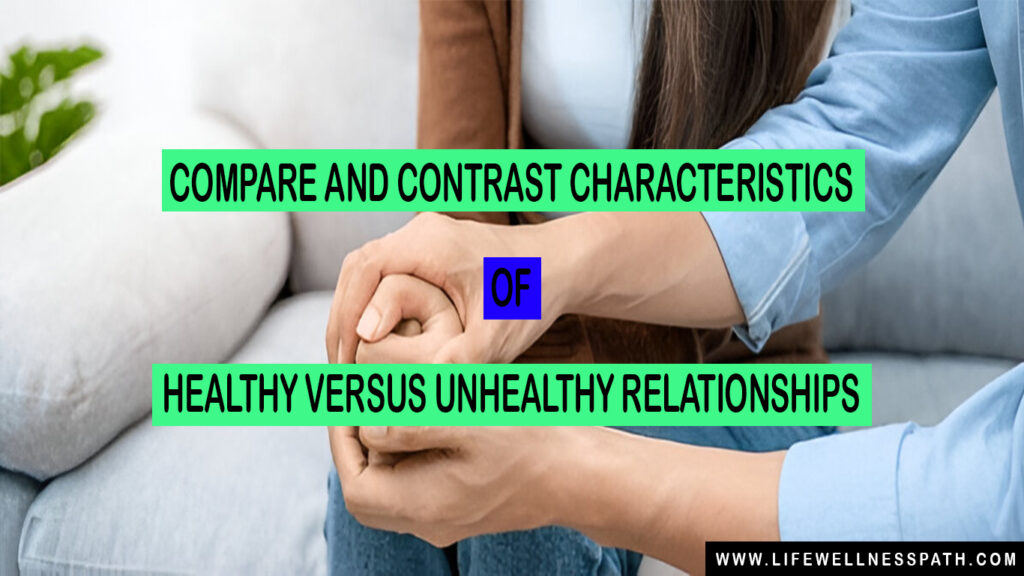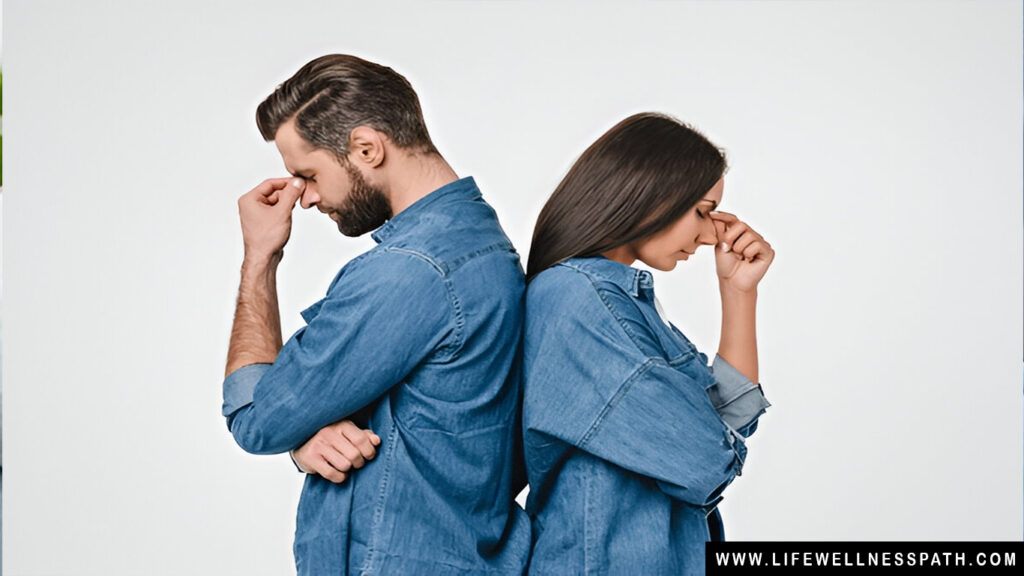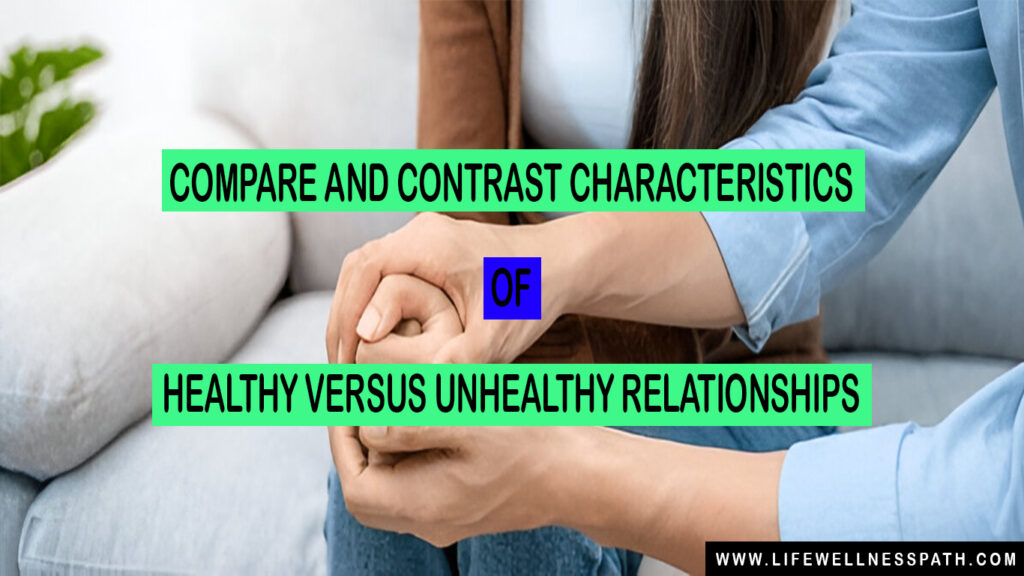Table of Contents
Introduction: Relationship Health – Why It Matters
Relationships are one of the most vital elements of our lives. Whether it’s with friends, own family, or romantic companions, the satisfactory of these connections could make or ruin our happiness and mental nicely-being. But how can we understand if we are in a healthy relationship or an bad one? In this weblog, we’re going to evaluate and contrast the characteristics of healthful as opposed to dangerous relationships, so that you can better understand what you deserve and a way to perceive purple flags.
Healthy relationships are rooted in mutual admire, consider, and emotional safety. On the alternative hand, bad relationships often contain manipulation, manipulate, and emotional damage. It’s smooth to confuse the 2, in particular whilst feelings are concerned, but studying the difference let you navigate your relationships with confidence and clarity.

Communication: Transparent vs. Toxic
In healthful relationships, verbal exchange flows easily. Both companions are capable to talk brazenly, actually, and without fear of being judged. Issues are addressed flippantly, and misunderstandings are cleared up with mutual recognize. This type of conversation fosters accepts as true with and deepens the connection between partners.
In assessment, poisonous communication in unhealthy relationships is frequently marked through avoidance, passive-aggressiveness, or outright manipulation. One associate may also close down when issues stand up, leaving the opposite inside the darkish. Or, even worse, one would possibly use harsh language or guilt to benefit manipulate. In such relationships, worry of communication frequently leads to growing resentment.
Conflict Resolution: Compromise vs. Escalation
No courting is free of conflict, but how the ones conflicts are dealt with is what virtually subjects. In a wholesome dating, struggle decision includes knowledge, compromise, and respect for each different perspectives. Partners pay attention to one another, and disagreements are solved without preserving grudges.
On the alternative hand, in dangerous relationships, conflicts boost quickly and are rarely resolved. Instead of addressing the difficulty, companions may play the blame sport or interact in personal attacks. This steady friction erodes agree with and leads to emotional exhaustion, making the connection sense extra like a battleground than a secure space.
Trust: Built Over Time vs. Constant Doubt
Trust is the foundation of any healthy relationship. It is built over time thru consistency, honesty, and preserving promises. In wholesome relationships, partners consider each other’s choices and intentions, creating a feel of emotional security.
In dangerous relationships, consider is shaky, regularly marked by way of jealousy, accusations, and paranoia. One partner may also constantly doubt the other’s loyalty or fidelity, even with none real proof. This loss of trust erodes the relationship from within, turning it into a steady source of anxiety in preference to comfort.
Emotional Support: Uplifting vs. Draining
A wholesome dating is a sanctuary where both partners sense emotionally supported. They uplift each other at some stage in tough times, celebrating each other’s successes without envy. Partners in healthy relationships recognize a way to be there for one another without making everything approximately themselves.
In contrast, dangerous relationships are emotionally draining. One companion may additionally demand consistent attention and assist even as presenting little in return. This imbalance creates emotional exhaustion for the supportive companion, leaving them feeling used instead of loved.
Respect: Mutual vs. Lopsided
Respect is on the center of a healthful dating. Partners honor each different feelings, boundaries, and individuality. They don’t try and control or manipulate but as a substitute recognize the variations that make each accomplice precise.
In an dangerous dating, admire is regularly one-sided or entirely absent. One companion may belittle or disregard the alternative’s emotions, critiques, or wishes. This lack of respect can appear in various ways, from subtle placed-downs to overt tries to control the alternative person’s existence.
Independence: Freedom vs. Control
Healthy relationships thrive on the stability of togetherness and independence. Partners assist each different character dreams and encourage personal boom. They consider every different sufficient to offer area while needed, knowing that their dating will stay sturdy.
In bad relationships, manipulate is usually a key problem. One associate may additionally experience threatened by way of the opposite’s independence and try to limit their freedom. Whether it is stopping them from seeing friends or making important lifestyles decisions, this manage creates a poisonous dynamic that stifles non-public increase.
Affection: Freely Given vs. Manipulative
Affection in a wholesome dating is given freely and joyfully. Partners revel in expressing love via bodily touch, kind words, and acts of service. This affection strengthens their bond and deepens emotional intimacy.
In a dangerous relationship, affection may be used as a device for manipulation. One companion would possibly withhold affection to punish the opposite or provide it handiest after they want something in return. This conditional affection creates an environment in which love feels transactional instead of real.
Self-Esteem: Elevated vs. Eroded
Healthy relationships raise your self-esteem. Partners are supportive and encourage every other to be the best variations of themselves. They celebrate every other’s achievement and help each different grow.
In an unhealthy relationship, however, shallowness takes a nosedive. Constant grievance, poor comparisons, or belittling remarks can erode your sense of self confidence. In such relationships, one accomplice can also feel like they’re never excellent enough, continuously in search of approval or validation from the other, who not often gives it. Instead of feeling uplifted, you may locate yourself questioning your price, which could have lengthy-time period consequences on your mental health.
Shared Goals: Unity vs. Disconnection
In a healthful relationship, each partner aligns on main life dreams. Whether it’s constructing a circle of relatives, growing a enterprise, or visiting the sector, they paintings as a group, helping each different goals and aspirations. Even whilst their character dreams vary, they find a manner to compromise or help every different achieve their separate pursuits.
In an unhealthy courting, there is a loss of unity. One associate might be absolutely indifferent to the alternative’s goals or, worse, attempt to sabotage them. Disconnection units in as both companions start to drag in exceptional instructions, making it experience as although they’re residing separate lives as opposed to constructing one together.
Boundaries: Respected vs. Violated
Healthy relationships thrive while personal barriers are reputable. Both companions understand that all of us wishes their personal area, and they honor the ones barriers without query. This creates a experience of safety and protection, understanding that your limits might be reputable.
In an unhealthy relationship, limitations are often violated. One companion may additionally overstep limits, invade privateness, or call for constant interest, brushing off the other’s need for private area. Over time, this may create emotions of suffocation, main to resentment and frustration.
Emotional Safety: Secure vs. Fearful
Emotional safety is crucial in a wholesome relationship. Partners sense secure expressing their emotions without worry of judgment or retaliation. When issues stand up, they talk thru them with empathy and information, fostering a feel of mutual emotional safety.
In a bad courting, emotional protection is compromised. Partners may worry being inclined, disturbing that their emotions may be used against them. As a result, they’ll bottle up their feelings, leading to emotional distance or outbursts of anger.
Growth: Encouraged vs. Stifled
A healthy courting encourages private growth. Partners encourage every different to pursue their desires, improve their skills, and emerge as better variations of themselves. There’s a feel of satisfaction in looking every different grow, understanding that the relationship plays a function of their development.
In contrast, unhealthy relationships often stifle increase. One companion might also experience threatened with the aid of the opposite’s fulfillment or independence, main to jealousy or resentment. Instead of assisting private evolution, they will try to hold their associate lower back, either consciously or subconsciously.
Decision-Making: Collaborative vs. Dominated
In a healthful courting, selection-making is a collaborative effort. Both companions have a say, and that they work collectively to locate answers that benefit them each. This applies to the entirety from financial selections to parenting selections, ensuring that neither partner feels unheard or left out.
In bad relationships, selection-making is regularly one-sided. One accomplice can also dominate the procedure, leaving the other feeling powerless or excluded. This imbalance can create resentment and cause conflicts down the line.
Criticism: Constructive vs. Destructive
Criticism is a natural a part of any dating, but in wholesome ones, it’s positive. Partners offer feedback with the aim of helping every different grow, and that they supply it with kindness and appreciate. Constructive criticism fosters improvement without unfavorable vanity.
In bad relationships, complaint is regularly unfavorable. One partner may additionally use it to rip down the opposite, that specialize in faults and shortcomings in a hurtful manner. This sort of complaint results in feelings of inadequacy, growing emotional wounds which are difficult to heal.
Jealousy: Minimal vs. Overwhelming
In a wholesome relationship, jealousy is stored in check. Partners consider every other and speak brazenly, decreasing feelings of lack of confidence. When jealousy does arise, it’s addressed frivolously and constructively.
In an unhealthy dating, jealousy is often overwhelming. One associate can be excessively possessive or insecure, leading to regular accusations and suspicion. This sort of jealousy can be suffocating, frequently resulting in controlling behaviors that push the connection into poisonous territory.
Manipulation: Absent vs. Frequent
Healthy relationships are constructed on honesty and transparency. There’s no need for manipulation because each companions speak openly about their wishes and dreams. They consider every different sufficient to share their feelings without resorting to manipulation.
In dangerous relationships, manipulation is a frequent tool used to govern or gain power. One accomplice may use guilt, deceit, or emotional blackmail to get their manner, undermining the opposite’s autonomy. Over time, this manipulation erodes consider and creates a toxic dynamic.
Conflict Frequency: Rare vs. Constant
In healthy relationships, conflicts are rare, and once they do arise, they’re resolved quick and maturely. Both companions are inclined to listen, compromise, and find answers that paintings for both events. Conflict decision will become a way to strengthen the relationship in preference to weaken it.
In unhealthy relationships, conflict is regular. Every small confrontation turns into a primary argument, and troubles are left unresolved, main to a buildup of resentment. This constant struggle creates an environment of tension and negativity, making the relationship feel like a battlefield.
Physical Intimacy: Mutual vs. Forced
Physical intimacy in a healthful relationship is mutual, consensual, and primarily based on emotional connection. Both companions sense snug expressing their dreams and respecting every different barrier, making intimacy an enriching revel in.
In unhealthy relationships, physical intimacy may be compelled, transactional, or used as a weapon. One accomplice would possibly stress the opposite into intimacy or withhold affection as a form of punishment. This bad dynamic can result in emotions of resentment and emotional distance.

External Relationships: Encouraged vs. Isolated
In a healthy relationship, external relationships are encouraged. Partners aid every other’s friendship and own family connections, know-how that those relationships upload price to their lives. They believe every other sufficient to keep bonds with others without feeling threatened.
In an unhealthy dating, one companion may try and isolate the alternative from pals and circle of relatives. They might experience insecure approximately external connections, fearing that these relationships will pull their accomplice away. Isolation creates dependency, making it harder for the isolated partner to are seeking assist or preserve their experience of identity.
Responsibility: Shared vs. Blamed
In a healthful relationship, each partners take responsibility for his or her actions and their contributions to the connection’s nicely-being. When things pass incorrect, they work together to find solutions without pointing palms.
In a dangerous courting, blame is frequently one-sided. One companion might also refuse to take responsibility for his or her actions, rather putting all the blame on the alternative. This imbalance creates a poisonous dynamic in which one accomplice feels crushed through guilt at the same time as the alternative avoids accountability.
Power Dynamics: Equal vs. Imbalanced
Power dynamics in a wholesome relationship are balanced. Both companions share choice-making duties and recognize each different autonomy. There’s no battle for manipulate, as both individuals experience similarly valued and empowered.
In an dangerous dating, power dynamics are imbalanced. One associate can also attempt to dominate the relationship, controlling decisions, price range, or even feelings. This imbalance creates emotions of resentment and can result in emotional or maybe bodily abuse.
Handling Criticism: Growth vs. Resentment
Criticism in a healthy dating is visible as an opportunity for increase. When one partner factors out a place for development, it’s achieved with kindness, and the recipient is open to change. This sort of remarks helps both companions evolve.
In an unhealthy courting, complaint breeds resentment. It’s often added harshly or with the goal of belittling the alternative individual. Instead of fostering boom, it creates surroundings of bitterness, wherein each companions feel attacked rather than supported.
Emotional Transparency: Honest vs. Guarded
Emotional transparency is prime to a healthful dating. Partners experience cushy sharing their feelings, fears, and insecurities without annoying approximately being judged. This openness strengthens emotional bonds and fosters believe.
In a dangerous relationship, emotional transparency is often absent. One or each companion may feel the want to protect their feelings, both because of worry of judgment or past experiences of being harm. This loss of openness leads to emotional distance and a breakdown in communique.
Sense of Belonging: Togetherness vs. Loneliness
In a healthful relationship, companions experience a strong sense of belonging. They revel in each different business enterprise and discover comfort in knowing that they’re part of a group. This sense of togetherness creates a sense of protection and happiness.
In a dangerous relationship, one or each companion might also sense lonely even when they’re collectively. The lack of emotional connection or constant conflicts can create an experience of isolation, making it experience as even though they’re going via lifestyles by myself despite being in a dating.
Conclusion: Choosing Health Over Harm
As we evaluate and evaluation the traits of wholesome versus unhealthy relationships, it will become clean that the key difference lies in mutual respect, consider, and emotional help. Healthy relationships permit for growth, protection, and emotional success, while unhealthy relationships drain you, leaving you feeling managed, insecure, or unloved.
Recognizing the signs of a wholesome or unhealthy relationship is step one in creating the connection you deserve. Whether you are currently in a dating or trying to input one, recollect which you deserve a partnership that builds you up as opposed to tears you down. By fostering open communique, mutual admire, and emotional help, you may create a bond that lasts and prospers.
Read More: 25 Essential Communication Skills for Success: Master Your Conversations Today
FAQ’s About: Compare and contrast characteristics of healthy versus unhealthy relationships
1. What is the distinction among a healthful courting and an unhealthy courting?
To examine and contrast characteristics of healthful versus dangerous relationships, it’s vital to look at trust, conversation, and recognize.
2. What are the characteristics of a bad courting?
Unhealthy relationships often show manipulation, loss of verbal exchange, and disregard when we compare and comparison characteristics of healthful as opposed to bad relationships.
3. What are the characteristics of a healthy courting?
Healthy relationships are marked by means of open communication, mutual recognize, and emotional aid, which we are able to compare and contrast with bad relationships.
4. What is the distinction among a healthy and unhealthy friendship?
When we compare and evaluation traits of healthful as opposed to unhealthy relationships, friendships have to exhibit agree with and support, whilst bad ones may additionally involve jealousy and manipulation.
5. How can I pick out dangerous relationship styles?
To efficaciously compare and assessment characteristics of healthy as opposed to dangerous relationships, look ahead to signs and symptoms like common grievance and shortage of support.
6. Can a healthful relationship grow to be unhealthy over time?
Yes, as you evaluate and comparison characteristics of wholesome versus unhealthy relationships, it’s essential to understand when dynamics shift in the direction of unhealthy patterns.
7. What function does verbal exchange play in healthful versus bad relationships?
Communication is fundamental; comparing and contrasting traits of healthy versus unhealthy relationships reveals that wholesome ones contain open communicate, even as dangerous ones often have misunderstandings.
8. How do boundaries range in healthful and bad relationships?
Boundaries are respected in healthful relationships, while in unhealthy ones, boundaries can be violated, highlighting key variations when we examine and comparison characteristics of healthful versus unhealthy relationships.
9. What effect does accept as true with have on courting health?
Trust is foundational in wholesome relationships, and comparing and contrasting characteristics of wholesome as opposed to dangerous relationships shows that a loss of accept as true with can result in toxicity.
10. How does emotional aid fluctuate in wholesome as opposed to unhealthy relationships?
Emotional help is a hallmark of healthful relationships, while unhealthy relationships can also lack this assist, making it easy to examine and contrast traits of both.
11. What are common symptoms of a wholesome dating?
Healthy relationships usually encompass appreciate, accept as true with, and powerful conversation while you examine and comparison characteristics of wholesome versus bad relationships.
12. What are common signs and symptoms of a bad courting?
Signs of unhealthy relationships can include manipulation, constant criticism, and absence of guide, which may be as compared and contrasted with healthful dynamics.
13. How do energy dynamics affect relationship health?
Power dynamics play a substantial role; comparing and contrasting characteristics of healthy as opposed to dangerous relationships reveals that stability fosters health, at the same time as imbalance can result in manipulate problems.
14. How can jealousy affect a relationship?
Jealousy is often general in dangerous relationships, and understanding this allows us evaluate and assessment traits of healthful as opposed to unhealthy relationships.
15. What should I do if I understand unhealthy developments in my courting?
If you spot dangerous developments, it’s essential to examine and assessment characteristics of healthy versus bad relationships and don’t forget searching for help or making changes.
16. How crucial is mutual appreciate in a courting?
Mutual recognize is crucial in healthy relationships, and when you evaluate and contrast characteristics of healthy as opposed to unhealthy relationships, a loss of admire often shows toxicity.
17. How do conflict decision styles fluctuate in healthy and unhealthy relationships?
Healthy relationships often contain constructive war decision, while bad ones may hotel to yelling or avoidance, making it easy to evaluate and comparison traits.
18. What is the impact of emotional intelligence on relationships?
Emotional intelligence fosters know-how and guide in healthy relationships; comparing and contrasting traits of healthful versus dangerous relationships shows that an absence can cause misunderstandings.
19. How does dependency play a function in courting dynamics?
In healthy relationships, partners support every differing’s independence, while unhealthy relationships may also showcase codependency, highlighting variations while we evaluate and evaluation traits.
20. Can beyond trauma have an effect on dating health?
Yes, past trauma can appreciably affect modern-day relationships, and it’s critical to compare and evaluation traits of healthful versus bad relationships to apprehend those dynamics.
21. How can I foster a healthful relationship?
To foster a healthy relationship, recognition on verbal exchange, respect, and emotional guide, all critical elements you may examine and comparison characteristics of healthful versus dangerous relationships.
22. What are the long-time period effects of being in a dangerous dating?
Long-time period outcomes may also encompass low self-esteem and intellectual health problems, which may be understood by means of comparing and contrasting characteristics of healthful as opposed to dangerous relationships.
23. How can friends assist someone in an unhealthy relationship?
Friends can offer aid and angle, assisting someone evaluate and contrast characteristics of healthful versus unhealthy relationships to look the crimson flags.
24. How do private values have an effect on dating dynamics?
Personal values play a vital function in courting health, and evaluating and contrasting characteristics of wholesome as opposed to bad relationships can monitor mismatches.
25. What position does vulnerability play in wholesome relationships?
Vulnerability fosters intimacy in healthful relationships, whilst in bad ones, it could result in exploitation, making it massive to evaluate and assessment traits.
26. How can conversation styles cause relationship problems?
Ineffective communique patterns can create misunderstandings, highlighting the differences when you examine and contrast traits of healthful versus bad relationships.
27. What is the significance of shared pursuits in relationships?
Shared pastimes can decorate connection in wholesome relationships, whilst a loss of not unusual floor can also imply bad dynamics, supporting to examine and evaluation characteristics.
28. How does physical intimacy range in healthy and unhealthy relationships?
Physical intimacy in wholesome relationships is mutual and consensual, while unhealthy relationships may additionally involve pressure, underscoring the want to compare and contrast traits.
29. Can professional assist improve relationship health?
Yes, expert help can provide equipment for conversation and understanding, assisting couples in comparing and contrasting characteristics of wholesome versus unhealthy relationships.
30. How can I ruin unfastened from a dangerous courting?
Recognizing the signs and symptoms is the first step; comparing and contrasting traits of healthy as opposed to bad relationships can guide you towards making empowered choices in your well-being.







